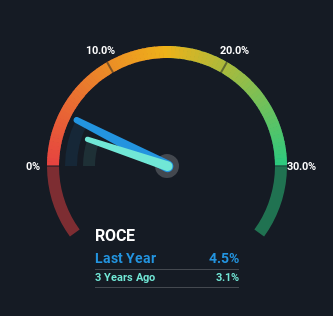- South Korea
- /
- Gas Utilities
- /
- KOSE:A036460
Returns On Capital At Korea Gas (KRX:036460) Have Hit The Brakes
If we want to find a stock that could multiply over the long term, what are the underlying trends we should look for? Ideally, a business will show two trends; firstly a growing return on capital employed (ROCE) and secondly, an increasing amount of capital employed. Put simply, these types of businesses are compounding machines, meaning they are continually reinvesting their earnings at ever-higher rates of return. Having said that, from a first glance at Korea Gas (KRX:036460) we aren't jumping out of our chairs at how returns are trending, but let's have a deeper look.
Return On Capital Employed (ROCE): What Is It?
If you haven't worked with ROCE before, it measures the 'return' (pre-tax profit) a company generates from capital employed in its business. Analysts use this formula to calculate it for Korea Gas:
Return on Capital Employed = Earnings Before Interest and Tax (EBIT) ÷ (Total Assets - Current Liabilities)
0.045 = ₩1.6t ÷ (₩57t - ₩23t) (Based on the trailing twelve months to December 2023).
So, Korea Gas has an ROCE of 4.5%. On its own that's a low return, but compared to the average of 3.2% generated by the Gas Utilities industry, it's much better.
View our latest analysis for Korea Gas

In the above chart we have measured Korea Gas' prior ROCE against its prior performance, but the future is arguably more important. If you're interested, you can view the analysts predictions in our free analyst report for Korea Gas .
How Are Returns Trending?
Over the past five years, Korea Gas' ROCE and capital employed have both remained mostly flat. It's not uncommon to see this when looking at a mature and stable business that isn't re-investing its earnings because it has likely passed that phase of the business cycle. So unless we see a substantial change at Korea Gas in terms of ROCE and additional investments being made, we wouldn't hold our breath on it being a multi-bagger.
Another point to note, we noticed the company has increased current liabilities over the last five years. This is intriguing because if current liabilities hadn't increased to 39% of total assets, this reported ROCE would probably be less than4.5% because total capital employed would be higher.The 4.5% ROCE could be even lower if current liabilities weren't 39% of total assets, because the the formula would show a larger base of total capital employed. With that in mind, just be wary if this ratio increases in the future, because if it gets particularly high, this brings with it some new elements of risk.
What We Can Learn From Korea Gas' ROCE
In a nutshell, Korea Gas has been trudging along with the same returns from the same amount of capital over the last five years. And investors appear hesitant that the trends will pick up because the stock has fallen 31% in the last five years. All in all, the inherent trends aren't typical of multi-baggers, so if that's what you're after, we think you might have more luck elsewhere.
On a separate note, we've found 1 warning sign for Korea Gas you'll probably want to know about.
If you want to search for solid companies with great earnings, check out this free list of companies with good balance sheets and impressive returns on equity.
Valuation is complex, but we're here to simplify it.
Discover if Korea Gas might be undervalued or overvalued with our detailed analysis, featuring fair value estimates, potential risks, dividends, insider trades, and its financial condition.
Access Free AnalysisHave feedback on this article? Concerned about the content? Get in touch with us directly. Alternatively, email editorial-team (at) simplywallst.com.
This article by Simply Wall St is general in nature. We provide commentary based on historical data and analyst forecasts only using an unbiased methodology and our articles are not intended to be financial advice. It does not constitute a recommendation to buy or sell any stock, and does not take account of your objectives, or your financial situation. We aim to bring you long-term focused analysis driven by fundamental data. Note that our analysis may not factor in the latest price-sensitive company announcements or qualitative material. Simply Wall St has no position in any stocks mentioned.
About KOSE:A036460
Korea Gas
Engages in the exploration, development, production, import, and wholesale of liquefied natural gas (LNG), compressed natural gas, and natural gas in Korea, Australia, Iraq, Mozambique, and Myanmar.
Good value average dividend payer.
Similar Companies
Market Insights
Community Narratives




